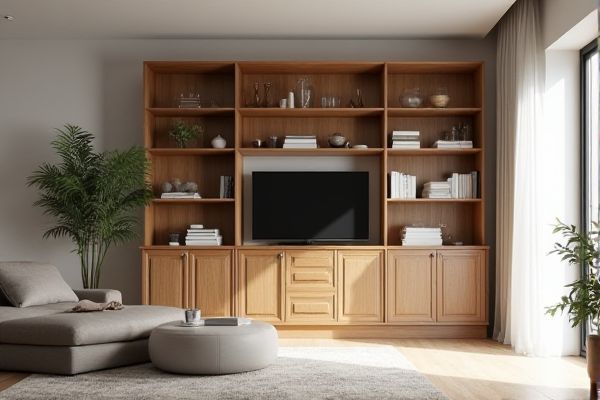
A hutch typically features a cabinet with shelves mounted on top of a lower section containing drawers or cabinets, designed for storing and displaying dishes and glassware, whereas a sideboard is a low, long piece of furniture primarily used for serving food and storing dining essentials like linens and flatware. Explore the rest of the article to understand which piece best suits Your dining room needs and style.
Table of Comparison
| Feature | Hutch | Sideboard |
|---|---|---|
| Design | Two-piece furniture with upper cabinets/shelves on a lower cabinet or table | Single, low-profile cabinet without upper shelving |
| Storage Type | Open shelving and enclosed cabinets for display and storage | Enclosed cabinets and drawers for concealed storage |
| Function | Display dishes, glassware, and decorative items | Store dining essentials like silverware, linens, and serving dishes |
| Placement | Commonly in dining rooms or kitchens against a wall | Placed in dining rooms, living rooms, or hallways |
| Height | Taller, often extending above waist height | Shorter, usually waist height or lower |
Hutch vs Sideboard: Key Differences
A hutch features an upper cabinet or shelving unit mounted on top of a lower cabinet, offering both display and storage space, while a sideboard is a long, low piece of furniture primarily designed for storage and serving. Hutch designs often highlight glass doors or open shelves ideal for showcasing dinnerware, whereas sideboards emphasize enclosed storage with drawers and cabinets. The key difference lies in vertical structure and dual-purpose display capabilities in hutches versus the predominantly horizontal, storage-focused functionality of sideboards.
What is a Hutch?
A hutch is a piece of furniture that consists of a set of shelves or cabinets placed above a lower unit, often a buffet or sideboard, designed for storage and display of dishes, glassware, or decorative items. Typically crafted from wood, hutches combine both enclosed cabinets and open shelving, maximizing functional space in dining rooms or kitchens. Unlike a sideboard, which is primarily a low storage unit, a hutch provides vertical storage and an elevated display area.
What is a Sideboard?
A sideboard is a versatile piece of furniture typically placed in dining rooms, designed for storage and serving purposes. It features a flat top surface, drawers, and cabinets to store dinnerware, linens, and utensils. Unlike a hutch, which often includes an upper shelving unit, a sideboard's focus is on horizontal storage and display space.
Functional Uses: Hutch vs Sideboard
A hutch typically combines upper cabinets with open shelving or glass doors for displaying dishes, while the lower part provides enclosed storage, making it ideal for kitchens or dining rooms that need both display and storage space. A sideboard primarily offers a flat surface for serving and drawers or cabinets below for storing dining essentials like silverware, linens, or serving dishes, optimizing your buffet setup during meals. Choosing between a hutch and a sideboard depends on your storage and display needs, as well as the space available in your dining area.
Choosing the Right Storage for Your Space
A hutch typically combines upper cabinets with a lower buffet, offering both enclosed storage and display space, making it ideal for dining rooms needing organized yet visible storage. A sideboard provides a flat surface with drawers and cabinets below, perfect for serving and storing items in compact spaces where countertop space is limited. Consider your room's size and usage patterns to determine whether a hutch's vertical storage or a sideboard's horizontal layout better suits your needs.
Design and Style Comparisons
Hutches typically feature a tall frame with open shelving or glass-front cabinets on top, combined with closed storage below, offering a blend of display and concealed storage ideal for dining rooms. Sideboards present a lower profile with a wider surface area, emphasizing accessible storage through drawers and cabinets, often enhancing dining spaces with a sleek, horizontal silhouette. Design choices between a hutch and sideboard depend on room height, storage needs, and stylistic preferences, with hutches leaning toward traditional or classic styles and sideboards fitting modern or minimalist aesthetics.
Materials and Durability
Hutches typically feature solid wood construction such as oak or maple, offering sturdy durability ideal for heavy storage and long-term use. Sideboards often incorporate a combination of wood veneers and engineered wood, balancing cost-effectiveness with moderate durability for everyday dining room use. Both furniture types may include metal hardware or glass inserts that enhance structural integrity and aesthetic appeal.
Best Rooms for Hutches vs Sideboards
Hutches are best suited for kitchens and dining rooms where vertical storage maximizes space for dishes and glassware, often combining cabinets with open shelving for display. Sideboards excel in living rooms, dining rooms, or entryways, offering wider surface areas for serving food, storing linens, and accommodating decorative items. Your choice depends on room layout and storage needs, with hutches ideal for compact vertical storage and sideboards for broader horizontal organization.
Maintenance and Care Tips
To maintain your hutch or sideboard, regularly dust surfaces with a soft, dry cloth to prevent buildup and preserve the finish. Avoid exposure to direct sunlight and moisture, which can cause warping or fading of wooden furniture. For deeper cleaning, use a mild wood cleaner and ensure you dry the surface thoroughly to protect the integrity and longevity of your pieces.
Cost and Value Considerations
Hutch furniture generally costs more than sideboards due to its larger size, added shelving, and more intricate design, offering greater storage versatility for dining rooms or kitchens. Sideboards are often more affordable and compact, providing essential storage for serving dishes and tableware without taking up excessive space. Evaluating both options involves balancing budget constraints against the need for storage capacity and aesthetic appeal to maximize value.
 homyna.com
homyna.com